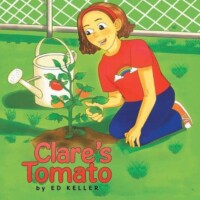Title: Clare’s Tomato
Author: Ed Keller
Publisher: LitPrime Solutions
ISBN: 979-8-88703-091-3
Pages: 56
Genre: Educational / Illustrated Children’s Book
Reviewed by: Beth Adams
Pacific Book Review
What is the difference between plants and animals? Well, in Clare’s Tomato readers learn that plants can make their own food from sunlight using chlorophyl, and animals need to eat food because they cannot make their own. This may seem obvious to adults, yet children need to learn ‘everything about everything’ and having this narrative from the author and educator Ed Keller, along with appropriate illustrations, Clare’s Tomato brings this foundation of knowledge to the inquisitive minds of youngsters in a very polished fashion.
In this book, readers are introduced to Clare, her mother and father, their neighbor Mr. Edwards and his dog Max. As the story progresses, readers see the wonders of nature in the growth of a tomato plant, and because it is given to Clare to attend to, she has to figure out how best to keep it watered, shaded from direct sunlight by filtering the light, and protected from small animals and insects. She observes how a green ball just under the leaf, of which she calls Greenie, grows larger and morphs from green to green-orange, then to orange-red, to become a red-ripened tomato.
So, it is decided that a structure needed to be built to preserve the safety of the tomato plant, which brings into the story a tangent of a decision process involving many design-decision criteria to make just the right thing needed – should it be a fence or a cage? What are the differences?
Author Ed Keller brings together other elements of the story, including a Great Dane dog named Max who, in a way, frightens Clare a bit due to his size, and the family’s neighbor Mr. Edwards, who seems to be quite the gardener, explaining to Clare many facts about growing different vegetables. The book is interleaved with questions designed to open a discussion with the readers on various subjects, keeping an open-scope of this information to be used for many other goals for children’s intellectual development. The illustrations are interspersed generously to allow for the readers’ visualizations of the characters and story elements.
Upon completion of this book, youngsters will have a mature and factual understand about many topics regarding growing food. It brings to point a philosophical human instinct about eating a tomato, which was observed since it was formed and named Greenie, or what other things can they do with this prized fruit?
Clare’s Tomato is an ideal book to adorn the family library, giving children a resource of information within a loving story-line, showing problem solving methodology along with the beauty of nature, including the kindness of family and neighbors. As a seed grows into a plant, the seed of wisdom within this book will grow and nurture a new generation of kindness and appreciation within children, and – who knows – perhaps even spur their dreams of becoming farmers when they become older.


